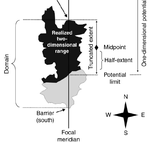Abstract
The most pervasive species-richness pattern, the latitudinal gradient of diversity, has been related to Rapoport’s rule, i.e., decreasing latitudinal extent of species’ ranges toward the equator. According to this theory, species can have narrower tolerances in more stable climates, leading to smaller ranges and allowing coexistence of more species.
We show, using a simple geometric model, that the postulated decrease of species’ potential range sizes toward the tropics would itself lead to a latitudinal gradient opposite to that observed. In contrast, an increase in extent of potential ranges toward the tropics would lead to the observed diversity gradient. Moreover, in the presence of geographic barriers constraining actual species’ ranges, Rapoport’s rule emerges if the latitudinal trend in extents of potential ranges (as defined by climatic tolerance) is opposite to that postulated or if variability in potential range extents decreases toward the poles. A strong implicit latitudinal diversity gradient (i.e., higher concentration of midpoints of species’ potential ranges in the tropics), however, produces both observed macroecological patterns without the contribution of any latitudinal trends in species climatic tolerances or in potential range sizes.
Our model underscores the necessity of discriminating theoretical processes and principles from the patterns we observe, and it is well supported by data on global distribution of species’ range sizes.
